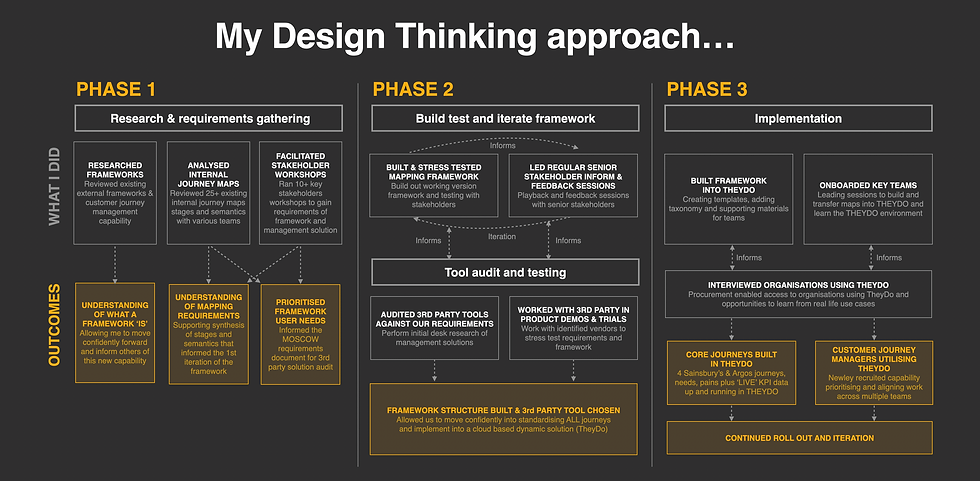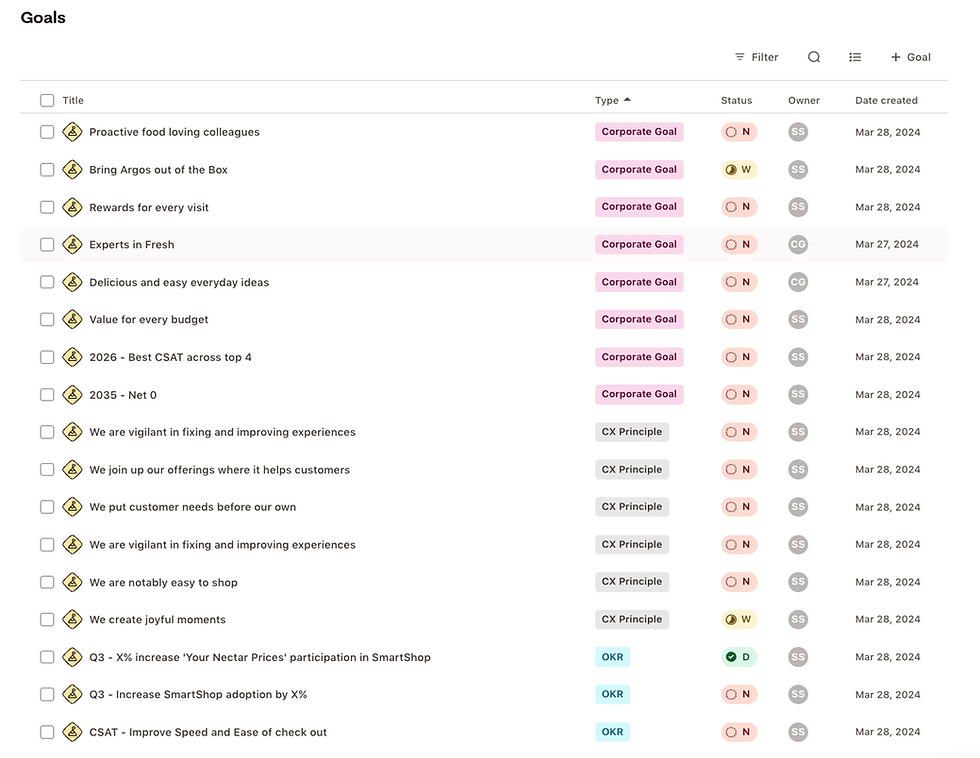
Sainsbury's Customer
Journey Framework
The challange
We needed to centralise, standardise and mobilise Customer Journey maps across the business to better support Customer Journey Management and drive change management.
Currently, our rich journey maps were: Difficult to locate, in formats not visible to the rest of the business, difficult to update and often overly complex.
My role(s)
Lead CX & Service Designer
-
Researched & delivered Sainsbury’s first customer journey framework
-
Led a high-profile & business-wide project
Stakeholder facilitator
& requirements co-ordinator
-
Ran multiple iterative sessions across various channels
-
Gathered statekholder needs and managed expectation
Implementation lead
with 3rd party supplier
-
Audited & implemented 3rd party solution
-
Supported internal adoption with vendor
1. Understanding our culture of journey mapping.
My initial research with 35+ stakeholders evidenced that 47 journey maps lived in 7 different formats, and almost each team had their own structures and semantics. For one business, we seemed to have endless flavours of maps.
Teams reported a multitude of unique problems and needs, but the one thing that did surface across nearly all teams was to get a 360 view of other work that was going on in their journey that may impact them. I made this a top requirement.
This confidently led me to my ‘4 Solution principles’ - Centralised, Democratised, Contextualised and Standardised - which remained the guiding (and measurable) principles moving forward.

Below: Journey building and stress testing workshops with 50+ stakeholders. Bringing all maps into one place allowed myself (and others) to start to work towards a more unified vision.

2. Designing a framework logic.
I love logic. So designing a journey framework that needed to span across on/offline, multiple brands and across multiple channels was satisfying. Complex for sure… but ultimately satisfying.
I soon started to understand that frameworks were made up of fundamentally 3 core elements: Zoom levels, taxonomy and input relationships.
Below: Framework ‘Levels' - Our ecosystem of journeys. All journeys, processes and flows had to be accommodated in the framework - the levels provided the hierarchy and 'detail' level.

Below: Journey Phases - The backbone that standardises them. This supports measurement metrics, semantics and structure to allow core and key end-to-end journeys to live under the same roof.

Below: Journey Inputs - Elements that give context and value. To aid prioritisation and monitoring, we laddered business goals through to insights and even connected these to solutions - aligning to our principle 'contextualised'.

Below: Our day 1 structure incorporating core journeys and linking associated lower-level 'nested' journeys. Although complex, teams gradually started to understand the structure moving from what was initially conceptual into a mapping reality.

3. Finding our Journey management tool - TheyDo
I completed an initial audit (including smaply, uxpressia and even 'Milkymaps'!) which highlighted TheyDo as best reacing our requirements.
I worked with Dev Ops, TheyDo and senior management to bring together and demo the first version of our framework in action. Although there were still issues and unknowns around data inputs and managing duplication and colleagues time on task - we decided to roll out for a trial period.
Below: Live journey in TheyDo. This was our first journey incorporating live CSAT data, validated insights and HMW's, solutions and as requested - visibility of work in flight initiatives across the supermarket journey.

Below: A quick look under the hood on how the framework & TheyDo supported our work.


Getting a view on CX gaps, fires and opportunities all in one place.
Having standardised our journey phases (or stages) we could now view and aggregate journeys against each other. It was the first time to could see work being down, unanswered HMW's and pain point hot spots across all our end-to-end journeys.

Assigning goals and CX principles to the work we go.
To ensure the work we did aligned with our strategy and key metrics, we had a governance triage process in place to review the work requests. This helped teams beyond CX to understand our allocation prioritise and enabled better conversations throughout.

Prioritisation matrix adds contextual information to HMW's.
Although we humans still had the final say in what we prioritised, by linking our goals, to insights, to HMW's etc... gave us a view of potential value of undertaking the work. If one potential solution concept overarched 3 HMW's, and resolved 6 pain points for example, then we could see that for the first time in context - in a map.
Outcomes
+30
Journeys built in TheyDo
+85
Map makers onboarded
+60
Stakeholder co-created solution
3
Number of times I heard CEO mention this work
+20
Departments having FULL visibility of all maps
1
Location for all maps, research & insights
Final Summary.
I’ll admit this was a challenging project, in fact many fellow designers told me they were glad they didn’t have to do it!
But this opportunity has really turbocharged my mapping skills to a seriously high level, and delivering on such a high profile project, given the complexity of the research, number of stakeholders and companywide visibility, is one of my biggest CX achievements.
More examples of work
Sainsbury's Supercharging SmartShop
A retrospective look at my role in understanding the SmartShop customer - and its innovation
CX Lead | Workshops | Research | Experiements

B&Q Kitchens
What could the future kitchen buying experience look like? We were commissioned by B&Q to conduct rapid research, CX audits, future journeys, validate opportunities and conduct a large opportunity survey to understand the perceived customer and business value

NatWest Covid Hub
When Covid starting closing down businesses in the UK, NatWest looked for ways to help its customers... quickly! I was CX Lead on creation of the Covid Hub and also the financial tools within it.

BNP Paribas
A new Global Head of Digital for the number 1 bank in France commissioned us to look at new ways to streamline and empower employees. As Lead UX on this project my team created an iPad app that would utilise existing client data and drive opportunity and sales
